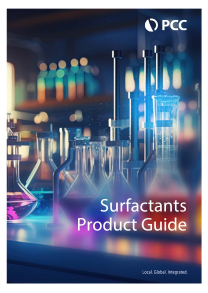Products catalog

The dynamic development of the surfactant industry is possible by the manufacturers’ focus on designing and developing innovative products used both in the production of consumer goods and in the technological processes.
Alkanolamides belong to the group of non-ionic surfactants. Their hydrophilic part is a mono- or diethanolamine group, while the hydrophobic part is a saturated or unsaturated carbon chain with a length of 8 to 22 carbon atoms. This group of compounds is obtained by reaction of fatty acids or their methyl esters with ethanolamines. The most popular representatives of alkanolamides are mono- and diethanolamides of coconut oil, rapeseed acid, oleic acid and lauric acid. They are in the form of light yellow to yellow liquid.
Increasing the length of the carbon chain reduces the solubility of these compounds in water, which is why higher molecular weight alkanolamides are used in oil-based formulations (e.g., in metalworking fluids). Dietanolamides are generally more soluble in water, while monoalkanolamides are more effective in building the viscosity of the formulation. Alkanolamides in the presence of other surfactants increase the viscosity and stability of the foam, as well as reduce the irritating effect of surfactants on the skin.
Alkanolamides are used as antistatic agents, softeners and as corrosion inhibitors. These compounds can be further modified by ethylene oxide, which enables obtaining their ethoxylated derivatives with high foaming capacity.
Subscribe to receive information about new products on the Product Portal and commercial information about the PCC Capital Group
Sienkiewicza 4
56-120 Brzeg Dolny
Poland
Przemysław Kanikowski
email: iod.rokita@pcc.eu